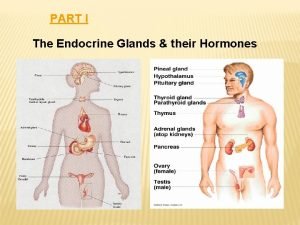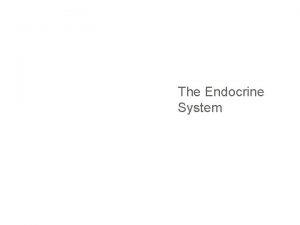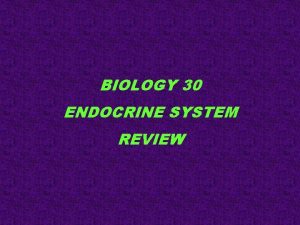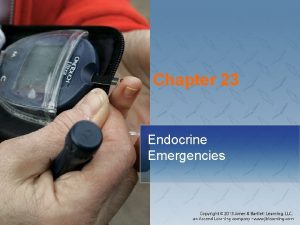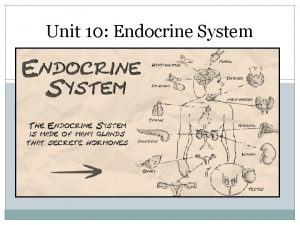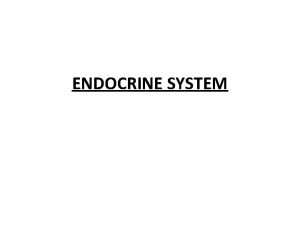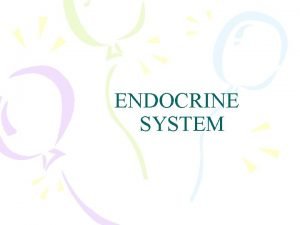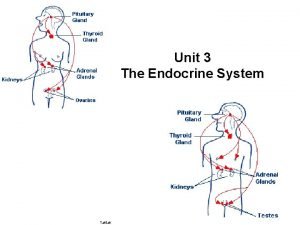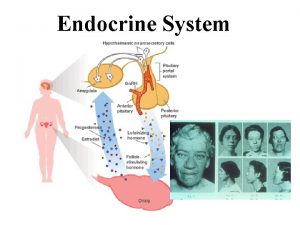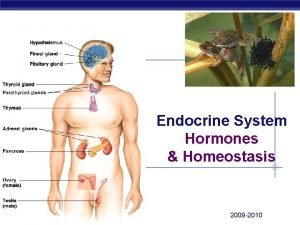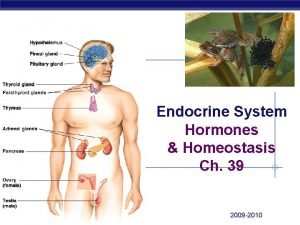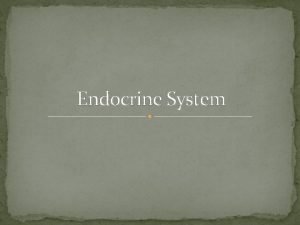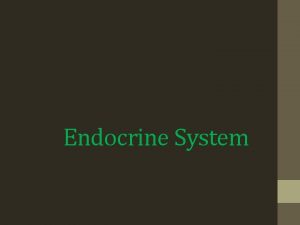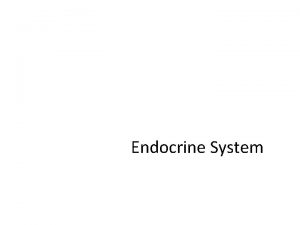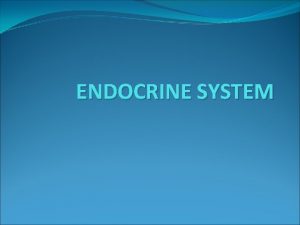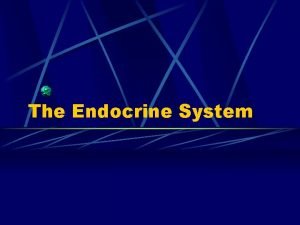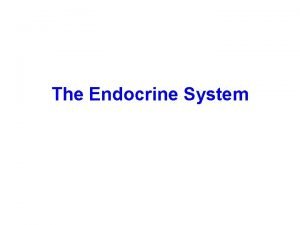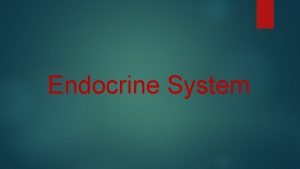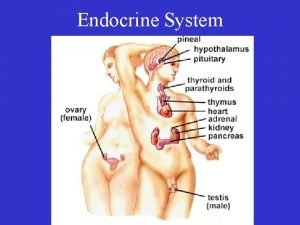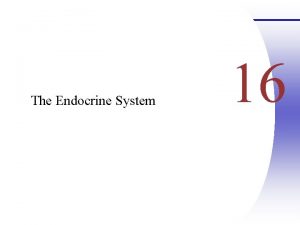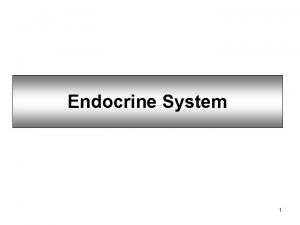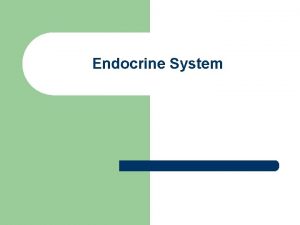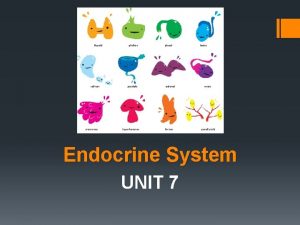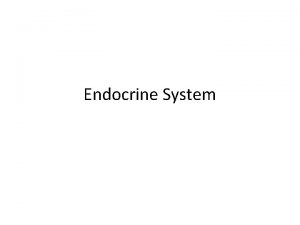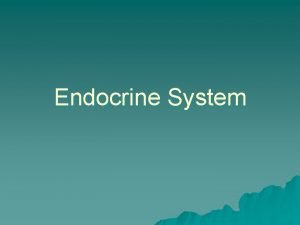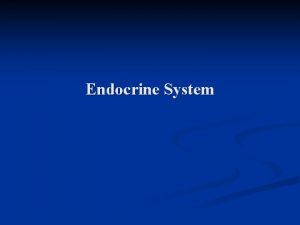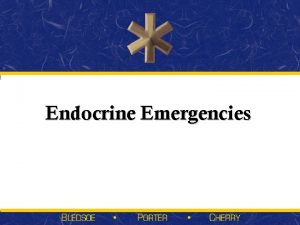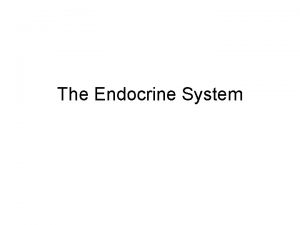The Endocrine System What is the Endocrine System

































- Slides: 33

The Endocrine System

What is the Endocrine System? • • The endocrine system is the collection of glands, all of which secrete different types of hormones that control metabolism, growth and development, tissue function, sexual function, reproduction, sleep and mood, along other things. Greek Meaning: endo- within - secrete crinis

• • • Glands The endocrine system is composed of 8 major glands: the hypothalamus, pituitary gland, thyroid gland, parathyroid gland, adrenal glands, pineal gland, reproductive glands, and pancreas Glands select and remove materials from the blood, process them, and secrete the finished chemical product for use somewhere in the body The glands are controlled directly by stimulation from the nervous system as well as by chemical receptors in the blood and hormones produced by other glands. These glands help to maintain the body’s homeostasis A group of glands that signal each other in sequence are usually referred to as an axis

Intro to the Endocrine System • • • The roles of hormones in selecting target cells and delivering the hormonal message Almost every organ in our body is affected by the endocrine system The endocrine system sends signals throughout the body, similar to the nervous system, but instead of immediate responses triggered by the nervous system, responses can take a few hours to weeks in the endocrine system The endocrine system gets some help from organs such as the kidney, liver, heart and gonads, which have secondary endocrine functions and secrete certain hormones.

https: //www. youtube. com/watch? v=gjm. S 4_7 kv. DM

Hormones and Receptors • • The endocrine system uses chemical messengers called hormones that are transported by the circulatory system (blood). They act on target cells that may be anywhere in the body Target cells have receptors that are specific to the signaling molecules. The binding of hormones to the receptors on or within the target cell produces a response by the target cell.

Hormones and Receptors cont.

Classes of Hormones Water-soluble hormones: include the peptide and amino acid hormones (insulin, epinephrine, HGH, and oxytocin). These hormones are soluble in water. They are unable to pass through the phospholipid bilayer of the plasma membrane and are therefore dependent upon receptor molecules on the surface of cells. When this cell binds to a receptor molecule on the surface of the cell, it triggers a reaction inside the cell. Lipid soluble hormones: include the steroid hormones (testosterone, estrogens, glucocorticoids, and mineralocorticoids). These hormones are able to pass directly through the phospholipid bilayer of the plasma membrane and bind directly to receptors inside the cell nucleus because they are lipid soluble. They are able to directly control the function of a cell from these receptors which often trigger the transcription of particular genes in the DNA to produce “messenger RNAs” that are used to make proteins that affect the cell’s growth and function.

Steps of Endocrine Functions 1. The nervous system sends impulses primarily to the brain, which triggers the function of the endocrine system 2. Specific hormones are secreted based on the messages to the brain 3. The hormones travel through the bloodstream across the plasma membranes of cells 4. Corresponding target cells have receptors which only receive certain hormones (this is called specificity) 5. Cells have special proteins which bind to hormones, controlling how much of the hormones is received

General Function • Maintenance of homeostasis in terms of balanced hormone levels and metabolic activity ● Negative Feedback System (most common) ○ Thyroid hormones ● Positive Feedback System ○ Childbirth

Endocrine System vs Nervous System Endocrine System • • • dispersed through the body depends on receptors in target cells slow signals/process long lasting effects Nervous System ● precise arrangement ● depends on anatomical placement ● rapid signals/ response ● short-term effects ● influences endocrine output influences CNS output Both systems enable cells to communicate with others by using chemical messengers

Hormone Responses • • Environmental condition to hormone o Some glands respond immediately to homeostatic changes Hormone to gland o Automatic hormone secretion maintenance

Hormone Regulation ● Nervous System- triggers hypothalamus ● Number of receptors- controls uptake ● Tropic Hormones- “two birds with one stone” ● Nutrition- maintenance of metabolic rate

Homeostatic Control • • • Metabolic rate Growth hormone Blood glucose levels Blood calcium levels Stress


Hypothalamus ● Located on the undersurface of the brain, below the thalamus and above the pituitary gland. The hypothalamus is approximately the size of a pea. ● Responsible for maintaining homeostasis, hormone production and controls the pituitary gland many other glands. ● The hormones produced in the hypothalamus regulate body temperature, thirst, hunger, sleep, mood and sex drive. ● There are two sets of nerve cells that produce hormones in the hypothalamus. The first sends the hormones to the posterior lobe of the pituitary gland out into the bloodstream. These hormones include the anti-diuretic hormones and oxytocin. The second set of nerve cells produces stimulating hormones that go to the anterior lobe of the pituitary gland which help regulate the hormones.

Pituitary Gland • • Very small gland located in the center of the skull. It is protected and surrounded by the sphenoid bone. There are two parts of the pituitary gland: the anterior pituitary gland (adenohypophysis) and the posterior pituitary gland (neurohypophysis). The adenohypophysis is a hormone producing gland that is made up of up granular epithelial tissue. The anterior pituitary glands produces many hormones: the human growth hormone, follicle-stimulating hormone, luteinizing hormone, prolactin, adrenocorticotropic hormone, and melanocytestimulating hormone. The neurohypophysis is nervous tissue extended from the hypothalamus that stores and releases hormones produced in the hypothalamus.

Thyroid • Butterfly shaped gland which lies in front of the trachea just below the larynx. • The two thyroid hormones, thyroxine and triidothyronine are produced from iodine in food. • These hormones are stored and released as needed, they help regulate and produce adrenaline, epinephrine, dopamine and metabolism. The thyroid gland also helps regulate calcium levels in the body. • The levels of hormones secreted are controlled by the pituitary gland’s thyroid-stimulating hormones, which are controlled by the hypothalamus.

Parathyroids • • There are four parathyroid glands which are located in the neck behind the thyroid. The main job of the parathyroid gland is to control the calcium. If calcium levels goes down, the parathyroid gland recognizes this and will make parathyroid hormone (PTH) which will go to the bone where calcium will be taken out and put into the blood. If the calcium level is too high, then it will make a less amount of PTH or will stop making it all together.

Adrenal Glands • • Triangle shaped, located on top of each kidney and controlled by the pituitary gland. The outer adrenal cortex produces the hormones aldosterone and cortisol. Aldosterone balances potassium and calcium which manages a persons blood pressure. Cortisol works along with adrenaline and noradrenaline which help regulate your body to stress. Along with that, cortisol helps regulate blood pressure, sugar levels and metabolism.

Pineal Gland

Reproductive Glands • • • The two major reproductive glands include the ovaries and the testes. The main source of sex hormones in males, androgens, are secreted by the testes which are located in the scrotum. The most important male reproductive hormone is testosterone which have an impact on many male characteristics such as the growth of facial hair and also sperm production. In females, the ovaries which are located on both sides of the uterus; produce estrogen, progesterone and eggs. These hormones control the female characteristic development such as breast growth.

Pancreas • • • Located in the upper abdomen and consist of two separate glands, the digestive exocrine gland the hormone producing endocrine gland. The exocrine gland allows the pancreas to excrete enzymes to break down proteins, carbohydrates, lipids and nucleic acids in food. The endocrine gland allows the pancreas to secrete the hormones insulin and glucagon which help control blood sugar levels.

Endocrine System Disorders What is an endocrine system disorder? a medical condition creating a hormonal imbalance Two groups of endocrine disorders: -disease results from hormone imbalance (too much or too little of a hormone) -develops due to lesions such as nodules or tumors which could or could not affect hormone levels Endocrine System Disorder Affects: -mood -growth and development -sexual function -reproduction

Hormone Imbalances hormone- chemical messenger for the body -even tiny amounts of changes in hormone levels can greatly affect the body How do hormone imbalances occur? - There may not be enough receptors, or binding sites, for the hormones. There may be a problem with regulating hormones in the blood stream. -due to problem with feedback from endocrine system, disease, genetic disorder, infections, injury or tumor of an endocrine gland, etc. hypersecretion- overproduction of hormone from a gland hyposecretion- underproduction of a hormone from a gland

Evaluating Disorders Pituitary Gland Disorders: can disrupt hormone production and normal functioning Thyroid Gland Disorders: affects the sympathetic nervous system and normal metabolism Parathyroid Gland Disorders: affects calcium levels in bone, blood, nerves, muscles, and other tissues Adrenal Gland Disorders: affects bone calcium levels, blood pressure, metabolism, and mental status Pancreatic Gland Disorders: includes diabetes, disrupts hormones such as insulin

Types of Disorders diabetes- most common endocrine system disorder; affects metabolism; pancreas doesn’t produce enough insulin adrenal insufficiency- adrenal gland releases too much hormone; symptoms: fatigue, upset stomach, dehydration, skin changes gigantism- pituitary gland produces too much growth hormone causes children to grow too fast hypothyroidism- not enough thyroid hormone is produced; symptoms: fatigue, dry skin, depression hyperthyroidism- body produces too much thyroid hormone; symptoms: fast heart, weight loss, fast heart rate, sweating, and nervousness Cushing's disease- overproduction of pituitary gland hormone which leads to overactive adrenal gland; causes swelling and obesity hypopituitarism- pituitary gland releases too little or no hormone; can be caused by many different diseases; symptoms: fatigue, weight loss

Types of Disorders multiple endocrine neoplasia I and II- a rare genetic condition that causes tumors of the parathyroid, adrenal, and thyroid glands; leads to overproduction of hormones; symptoms include abnormal bone structure, being tall and slender polycystic ovary syndrome- overproduction of androgens; interferes with development of eggs and release from ovaries precocious puberty- abnormally early puberty; occurs when glands tell body to release hormones too soon thyroid cancer- cancer begins in thyroid gland, grows, and forms a tumor metabolic disorder- abnormal chemical reactions disrupt metabolic rate; could lead to dysfunction of the liver and pancreas (diabetes falls under this category) dwarfism- pituitary gland does not produce enough growth hormone; reduces muscle and bone growth acromegaly- overgrowth of the flat bone of the face due to excessive growth hormone acromegaly

Testings and Treatments endocrinologist- specially trained in endocrine system -symptoms vary widely so can be difficult to diagnose -modern treatment is effective -mild cases often don’t require treatment -can be treated by correcting hormonal imbalance -most common symptoms are fatigue and weakness -synthetic hormones can be administered -blood and urine tests can be used to check hormone levels -surgery or radiation can be used in cases of tumors or nodules -imaging testing can be used to locate tumors

Risk Factors - elevated cholesterol levels -family history of an endocrine disorder -inactivity -poor diet -recent surgery/treatment -pregnancy Reduce the Risk by: -eating a well-balanced diet -get adequate exercise -lowering stress levels -getting enough sleep

Works Cited http: //www. livescience. com/26496 -endocrine-system. html http: //www. innerbody. com/image/endoov. html http: //www. pamf. org/endocrinology/services/faqs. html http: //www. healthgrades. com/procedures/endocrine-disorders http: //www. endocrineweb. com/ http: //www. ssa. gov/disability/professionals/bluebook/9. 00 -Endocrine-Adult. htm http: //www. physiologyinfo. org/mm/What-is-Physiology/Endocrine/Diseases-of-the-Endocrine-System. html http: //www. hormone. org/diseases-and-conditions http: //www. pennmedicine. org/health_info/body_guide/reftext/html/endo_sys_fin. html#homeostatic http: //arbl. cvmbs. colostate. edu/hbooks/pathphys/endocrine/basics/control. html http: //www 2. estrellamountain. edu/faculty/farabee/biobk/biobookendocr. html http: //health. howstuffworks. com/human-body/systems/endocrine-system-ga. htm http: //faculty. stcc. edu/Aand. P/AP/AP 2 pages/Units 14 to 17/endocrine/hormonal. htm http: //www. innerbody. com/image/endoov. html

Works Cited Continued http: //themindunleashed. org/2013/09/activating-your-pineal-gland. html http: //www. healthline. com/human-body-maps/hypothalamus#5/3 http: //www. innerbody. com/image/endo 01. html#full-description http: //www. webmd. com/a-to-z-guides/thyroid-gland http: //www. healthline. com/human-body-maps/thyroid-gland#3/7 http: //www. healthline. com/health/adrenal-glands#Definition http: //www. emedicinehealth. com/anatomy_of_the_endocrine_system/page 8_em. htm http: //parathyroid. com/parathyroid. htm

Video https: //www. youtube. com/watch? v=gjm. S 4_7 kv. DM
 Endocrine system and reproductive system
Endocrine system and reproductive system Endocrine system vs nervous system
Endocrine system vs nervous system Lympathic
Lympathic Nervous system vs endocrine system venn diagram
Nervous system vs endocrine system venn diagram Adh function
Adh function Chapter 16
Chapter 16 Adenohypophysis
Adenohypophysis Sympathetic nervous system
Sympathetic nervous system Comparison of endocrine and nervous system
Comparison of endocrine and nervous system Steroids endocrine system
Steroids endocrine system Facts about the endocrine system
Facts about the endocrine system Rat external anatomy
Rat external anatomy Oxication
Oxication Humoral neural and hormonal stimuli
Humoral neural and hormonal stimuli Are endocrine glands ductless
Are endocrine glands ductless Chapter 7:13 endocrine system
Chapter 7:13 endocrine system Mammillary body
Mammillary body Humoral stimulus
Humoral stimulus Hypothal
Hypothal Biology 30 endocrine system
Biology 30 endocrine system Sella turcica
Sella turcica Chapter 23 the endocrine system
Chapter 23 the endocrine system Endocrine system analogy
Endocrine system analogy Endocrine system introduction
Endocrine system introduction Endocrine system abbreviations
Endocrine system abbreviations T4.taktak
T4.taktak Endocrine system
Endocrine system Endocrine system
Endocrine system Baylor
Baylor Endocrine glands
Endocrine glands Endocrine system
Endocrine system Unit 6 human development lesson 1 pregnancy
Unit 6 human development lesson 1 pregnancy Endocrine system regents questions
Endocrine system regents questions Endocrine system regents questions
Endocrine system regents questions






